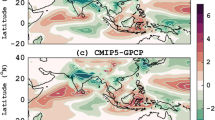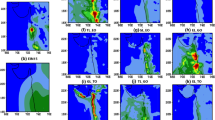Abstract
In this study the simulation of the variability and extremes of daily rainfall during the Indian summer monsoon for the present-day and the future climate is investigated. This is done on the basis of a global time-slice experiment (TSL) with the ECHAM4 atmospheric general circulation model (GCM) at a high horizontal resolution of T106. The first time-slice (period: 1970–1999) represents the present-day climate and the second (2060–2089) the future climate. Moreover, observational rainfall data from the Global Precipitation Climatology Project (GPCP, 1997–2002) and rainfall data from the ECMWF re-analysis (ERA, 1958–2001) are considered. ERA reveals serious deficiencies in its representation of the variability and extremes of daily rainfall during the Indian summer monsoon. These are mainly a severe overestimation of the frequency of wet days over the oceans and in the Himalayas, where also the rainfall intensity is overestimated. Further, ERA shows unrealistically heavy rainfall events over the tropical Indian Ocean. The ECHAM4 atmospheric GCM at a horizontal resolution of T106, on the other hand, simulates the variability and extremes of daily rainfall in good agreement with the observations. The only marked deficiencies are an underestimation of the rainfall intensity on the west coast of the Indian peninsula and in Bangladesh, an overestimation over the tropical Indian Ocean, due to an erroneous northwestward extension of the tropical convergence zone, and an overestimation of the frequency of wet days in Tibet. Further, heavy rainfall events are relatively strong in the centre of the Indian peninsula. For the future, TSL predicts large increases in the rainfall intensity over the tropical Indian Ocean as well as in northern Pakistan and northwest India, but decreases in southern Pakistan, in the centre of the Indian peninsula, and over the western part of the Bay of Bengal. The frequency of wet days is markedly increased over the tropical Indian Ocean and decreased over the northern part of the Arabian Sea and in Tibet. The intensity of heavy rainfall events is generally increased in the future, with large increases over the Arabian Sea and the tropical Indian Ocean, in northern Pakistan and northwest India as well as in northeast India, Bangladesh, and Myanmar.










Similar content being viewed by others
References
Bengtsson L, Botzet M, Esch M (1995) Hurricane-type vortices in a general circulation model. Tellus 47A: 175–196
Bengtsson L, Hodges KI, Hagemann S (2003) Sensitivity of large scale atmospheric analyses to humidity observations and its impact on the global water cycle and tropical and extra-tropical weather systems. MPI-Report 347, pp 26
Bhaskaran B, Mitchell JFB (1998) Simulated changes in Southeast Asian monsoon precipitation resulting from anthropogenic emissions. Int J Climatol 18: 1455–1462
Bhaskaran B, Mitchell JFB, Lavery JR, Lal M (1995) Climatic response of the Indian subcontinent to doubled CO2 concentration. Int J Climatol 15: 873–893
Coles S (2001) An introduction to statistical modeling of extreme values. Springer, Berlin, Heidelberg, London, pp 208
Dümenil L, Bauer H-S (1998) The tropical easterly jet in a hierarchy of GCMs and in reanalyses. MPI-Report 247, pp 45
Gadgil S, Asha G (1992) Intraseasonal variation of the Indian summer monsoon. J Meteorol Soc Japan 70: 517–527
Gregory JM, Mitchell JFM (1995) Simulation of daily variability of surface temperature and precipitation over Europe in the current and 2 × CO2 climates using the UKMO climate model. Q J R Meteorol Soc 121: 1451–1476
Groisman PY, Karl TR, Easterling DR, Knight RW, Jamason PF, Hennessey KJ, Suppiah R, Page CM, Wibig J, Fortuniak K, Razuvaev VN, Douglas A, Førland E, Zhai P-M (1999) Changes in the probability of heavy precipitation: important indicators of climatic change. Clim Change 42: 243–283
Hosking JRM (1990) L-moments: analysis and estimation of distributions using linear combinations of order statistics. J R Statist Soc B52: 105–124
Houghton JT, Callandar BA, Varney SK (eds) (1992) Climate change 1992: the supplementary report to the IPCC scientific assessment. Cambridge University Press, Cambridge, pp 198
Houghton JT, Ding Y, Griggs DJ, Noguer M, van der Linden PJ, Dai X, Maskell K, Johnson CA (eds.) (2001) Climate change 2001. The scientific basis. Cambridge University Press, Cambridge, pp 881
Hu Z-Z, Latif M, Roeckner E, Bengtsson L (2000) Intensified Asian summer monsoon and its variability in a coupled model forced by increasing greenhouse gas concentrations. Geophys Res Lett 27: 2681–2684
Huffman GJ, Adler RF, Arkin P, Chang A, Ferraro R, Gruber A, Janowiak J, McNab A, Rudolf B, Schneider U (1997) The Global Precipitation Climatology Project (GPCP) combined precipitation data set. Bull Am Meteorol Soc 78: 5–20
Huffman GJ, Adler RF, Morrissey MM, Bolvin DT, Curtis S, Joyce R, McGavock B, Susskind J (2001) Global precipitation at one-degree daily resolution from multisatellite observations. J Hydrometeorol 2: 36–50
Kållberg P, Gibson JK, Hernandez A, Onogi K, Saarinen S, Uppala S, Li X (1999) The ECMWF 40-year re-analysis (ERA40): validation of the intended system. Proc 10th Symp Global Change Studies, Dallas, Texas, USA, pp 373
Katz RW (1999) Extreme value theory for precipitation: sensitivity analysis for climate change. Adv Water Res 23: 133–139
Keshavamurty RN (1973) Power-spectra of large-scale disturbances of the Indian southwest monsoon. Ind J Meteorol Geophys 24: 117–124
Kitoh A, Yukimoto S, Noda A, Montoi T (1997) Simulated changes in the Asian summer monsoon at times of increased atmospheric CO2. J Meteorol Soc Japan 75: 1019–1031
Krishnamurthy V, Shukla J (2000) Intraseasonal and interannual variability of rainfall over India. J Clim 13: 4366–4377
Krishnamurti TN, Ardanuy P (1980) The 10 to 20 day westward propagating modes and “breaks in the monsoons”. Tellus 32: 15–26
Krishnamurti TN, Bhalme HN (1976) Oscillations of the monsoon system. Part I: observational aspects. J Atmos Sci 33: 1937–1954
Krishnamurti TN, Subramanian D (1982) The 30–50 day mode at 850 mb during MONEX. J Atmos Sci 39: 2088–2095
Lal M, Meehl GA, Arblaster JM (2000) Simulation of Indian summer monsoon rainfall and its intraseasonal variability. Reg Environ Change 1:163–179
Martin GM (1999) The simulation of the Asian summer monsoon, and its sensitivity to horizontal resolution, in the UK Meteorological Office Unified Model. Q J R Meteorol Soc 125:1499–1525
May W (1999) A time-slice experiment with the ECHAM4 A-GCM at high resolution: the experimental design and the assessment of climate change as compared to a greenhouse gas experiment with ECHAM4/OPYC at resolution. DMI Scientific Report 99-2, pp 93
May W (2001) The impact of horizontal resolution on the simulation of seasonal climate in the Atlantic/European area for present and future times. Clim Res 16: 203–223
May W (2002) Simulated changes of the Indian summer monsoon under enhanced greenhouse gas conditions in a global time-slice experiment. Geophys Res Lett 29: 10.1029/2001GL013808
May W (2003) The Indian summer monsoon and its sensitivity to the means SSTs: simulations with the ECHAM4 AGCM at T106 horizontal resolution. J Meteorol Soc Japan 81: 57–83
May W, Roeckner E (2001) A time-slice experiment with the ECHAM4 AGCM at high resolution: the impact of horizontal resolution on annual mean climate change. Clim Dyn 17: 407–420
Meehl GA, Washington WM (1993) South Asian summer monsoon variability in a model with a doubled atmospheric carbon dioxide concentration. Science 260: 1101–1104
Nijssen B, O’Donnell GM, Lettermaier DP, Lohmann D, Wood EF (2001) Predicting the discharge of global rivers. J Clim 14: 3307–3323
Roeckner E, Arpe K, Bengtsson L, Christoph M, Claussen M, Dümenil L, Esch M, Giorgetta M, Schlese S, Schulzweida U (1996) The atmospheric general circulation model ECHAM-4: Model description and simulation of present-day climate. MPI-Report 218, pp 90
Roeckner E, Bengtsson L, Feichter J, Lelieveld J, Rodhe H (1999) Transient climate change simulations with a coupled atmosphere-ocean GCM including the tropospheric sulfur cycle. J Clim 12: 3004–3032
Rudolf B (1993) Management and analysis of precipitation data on a routine basis. Proc Int Symp Precipitation and Evaporation, Bratislava, Slovakia, pp 69–76
Semenov VA, Bengtsson L (2002) Secular trends in daily precipitation characteristics: greenhouse gas simulation with a coupled AOGCM. Clim Dyn 19: 123–140
Sikka DR (1977) Some aspects of the life history, structure and movement of monsoon depressions. Pure Appl Geophys 115: 1501–1529
Stendel M, Roeckner E (1998) Impacts of horizontal resolution on simulated climate statistics in ECHAM4. MPI-Report 253, pp 57
Stephens MA (1970) Use of the Kolmogorov-Smirnov, Cramer-von-Mises and related statistics without extensive tables. J R Statist Soc B32: 115–122
Stephenson DB, Rupa Kumar K, Doblas-Reyes FJ, Royer J-F, Chauvin F (1999) Extreme daily rainfall events and their impact on ensemble forecasts of the Indian monsoon. Mon Weather Rev 127: 1954–1966
Tiedke M (1989) A comprehensive mass flux scheme for cumulus parametrization in large-scale models. Mon Weather Rev 117: 1179–1800
Voss R, May W, Roeckner E (2002) Enhanced resolution modelling study on anthropogenic climate change: changes in extremes of the hydrological cycle. Int J Climatol 22: 755–777
Webster PJ, Magaña VO, Palmer TN, Shukla J, Tomas RA, Yanai M, Yasunari T (1998) Monsoons: processes, predictability and prospects for prediction. J Geophys Res 103: 14,451–14,510
Wilks DS (1990) Maximum likelihood estimation for the gamma distribution using data containing zeros. J Clim 3: 1495–1501
Wilks DS (1995) Statistical methods in the atmospheric sciences. Academic Press, San Diego, USA, pp 467
Zwiers FW, Kharin VV (1998) Changes in the extremes of the climate simulated by CCC GCM2 under CO2 doubling. J Clim 11: 2200–2222
Acknowledgements.
This work was supported by the European Commission through the PROMISE (Predictability and variability of monsoons and the agricultural and hydrological impacts of climate change) project under contract EVK2-1999-00022. The 1.0° daily rainfall data were provided by the NASA/Goddard Space Flight Center’s Laboratory for Atmospheres, which develops and maintains this data set as a contribution to the GEWEX Global Precipitation Climatology Project.
Author information
Authors and Affiliations
Corresponding author
Rights and permissions
About this article
Cite this article
May, W. Simulation of the variability and extremes of daily rainfall during the Indian summer monsoon for present and future times in a global time-slice experiment. Climate Dynamics 22, 183–204 (2004). https://doi.org/10.1007/s00382-003-0373-x
Received:
Accepted:
Published:
Issue Date:
DOI: https://doi.org/10.1007/s00382-003-0373-x




